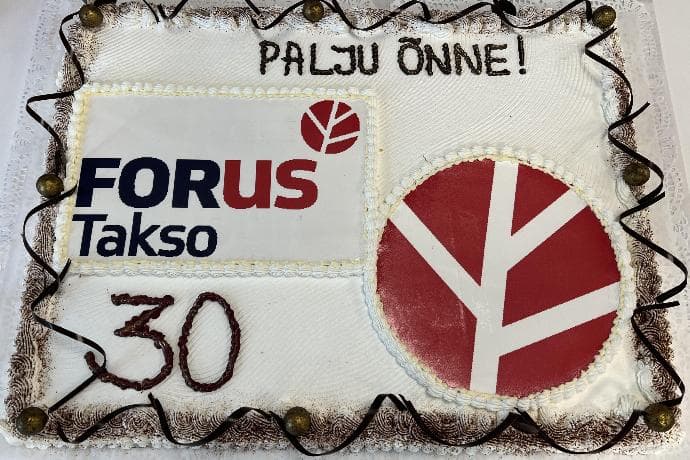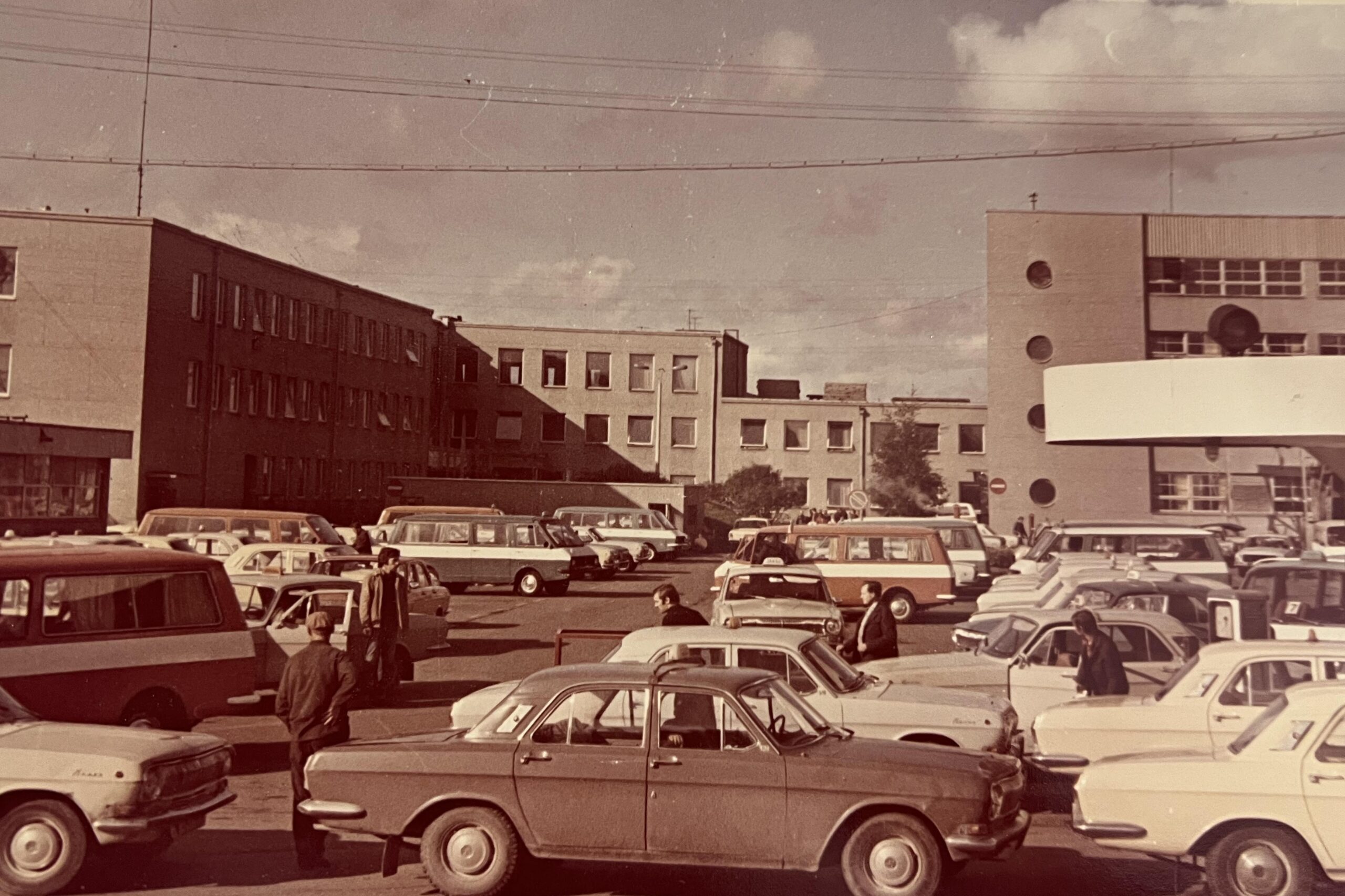Tiit Isop, CEO of Forus Takso, who has been in the taxi business for a long time, believes that just like not everyone will use self-driving cars in the future, not everyone will order a taxi via an app. People will decide whether the classical taxi will stick around or not. The CEO of Forus Takso himself believes it will.

Estonia’s largest and oldest taxi company, Forus Takso (formerly Tulika), will celebrate its 30th anniversary in early June. In the capital, Forus seems to be everywhere. In fact, 85 per cent of its market is elsewhere, but the brand does stand out. Tiit Isop, whose birthday is on the same day as International Taxi Driver Day (22 March), admits that there are many people who do not believe that classic taxis still have such a large share in the world today and that the number of customers has not decreased.
Tiit, are customers already used to the name of Forus Takso or are they still asking Tulika Takso by calling 1200? Did this change of brand more than a year ago lead to doubts and hesitations?
I have to admit, there were people who were sceptical that we ended a brand that had been on the market for 28 years and it was thought that the Finns would ignore us in the port.
I personally have never had any doubts about this – if the quality remains the same, then there is no need to worry. Of course, there are those who continue to call it Tulika Takso. It will last for a long time and people will have it in their memory, but Forus has become quite common already. For some people, Circle K will also forever remain Statoil. I believe the presence – to know that a taxi is there for them – is more important for the people.
When we took a Toyota RAV4 into our taxi fleet, people said, ‘Who would ride in a jeep as a taxi?’ Actually, the cityscape immediately changed for the client, becoming bigger and taller. If the car is comfortable, it does not matter who is behind the phone number 1200. I believe that the design that the Forus taxis have and this aggressive presence in the cityscape is enjoyable!

You have been involved in the taxi business for a long time. How and when did you get started?
My first note in the former employment record book is from 1987, at the Tallinn Taxi Park. I went to a branch of the taxi park (at 1 Staadioni Street). There were a few fancier black Volgas that were rented and maintained there. They served the ministries.
Then, there was a long pause. In 1998, Mati Saar, the founder of Tulika Takso and long-time owner of the company, invited me to work with a car rental company, namely VIP taxis or the black Mercedes cars. That is where this journey began for me. In the meantime, I also prepared the taxi platform Taxofon. I would say that I have not been able to step out of this business since 1998. My task from 2016 to today has been launching new apps and getting a feel of the landscape.
We are not just your classic taxi. One part of our business is still a taxi dispatch service, but the other direction is Forus Taxi and the app world, in which we are also actively involved.
Have you worked as a taxi driver yourself?
I once made an agreement with the taxi drivers that I would not do that. There is the risk that if you come and drive along the other drivers, it will be difficult to lead others later on.
I have been a taxi driver as a student at TIP (currently Tallinn University of Technology). If someone asks me if I know what a pirate taxi is, then I did drive a pirate taxi for quite a few weekends :). It was a criminal offence and a crime. In the Soviet era, I would have probably been thrown in jail for that. Of course, I was not the only one. Basically, I drove to the taxi stop at the Tallinn Bus Station and asked the people there if anyone wanted to go to Õismäe. This was an option for making some extra cash, which is now called part-time employment or app taxi. It certainly was exciting for a young man. It was also a time when people were standing in line at a taxi stop. Right now, the opposite is true – taxis are queuing and waiting for someone to order a taxi.
Pirate taxis have not gone anywhere today, either, have they?
If you do not have a service provider and a vehicle card nor any permit, then it is considered a pirate taxi. However, everything has been made very easy on today’s landscape, so nobody has to deal with fraud. You get a service provider’s card, register yourself on the app, and go out to drive on a Friday night. There still are pirate taxis, but they do not have a large market.
The cars of Forus Takso can currently be seen widely around the city and the taxis serve customers by hotels, the port, and the airport. Have these places remained relatively the same for 30 years?
Yes, you could say so. Viru Hotel has been working with us since the beginning. We have gotten some more hotels over time, such as Hilton, for example. The port with its terminals is still where it always has been and the airport is also nearby. Between 10,000–15,000 people per month leave the airport with our cars. It has been a stable service over the years, with the hotels and ports. We have been very strong in our niche in this service and we have a good reputation.
We have always had contracts and we take responsibility. Sometimes, if there are not five available cars in front of the Viru Hotel, we get calls asking where our cars are. The same goes for the airport and the port.
Decades ago, there was the large Tallinn Taxi Park in the Kristiine district, where the drivers gathered and socialised.
The area where the Kristiine centre currently stands used to be a car park. There was a large taxi park along with car washes and mechanics’ workshops there. Taxi drivers were also able to engage in various recreational activities and sports there. The establishment of Kristiine centre was a big change. The car park was razed and they started building a shopping centre.
Later, in the early 2000s, we used the address 34 Tihase Street as a parking lot. Drivers had a place there to take their cars to and from. Back then, you drove with two men. Today, it has become a one-man model – the car is always in the driver’s hands and it is up to them how much they work.
What has been the most important turning point in the 30-year history of the taxi business? Can we divide this time into sections in some way?

Many considered it ridiculous when Mati Saar created Tulika Takso in 1993, as they started driving with Western cars. There were Opel cars in our taxi park in addition to Volgas. Tulika already achieved a certain niche at that time, and everyone knew that we were driving more expensive and higher-quality cars. This impression still accompanies us. In the first ten years, everyone began to realise that if you do not follow this model, your quality will lag behind by a lot.
The next decade in our history was probably a more stable time. At that time, Tallink also entered the market as a large classical taxi company and started to offer competition. This was in 2008.
The arrival of Tallink initially frightened us due to the fact that they were coming from a large shipping business and with a large wallet. It seemed like they would steamroll us. However, the current situation is that our taxi fleet is thrice as large and we have managed to fit into the market together.
The third decade brought with it the age of the app. People started saying that the right taxis come from Bolt and Uber. We were wondering where these cheaper prices would end up at, but the race continues to this day. At the same time, it has also brought many new customers to the market. This is an era that is still ongoing.
The main task of a taxi driver is to take people from point A to point B. Has anything changed in the work of a taxi driver in 30 years?
First and foremost, the expectations of the clients have changed. In the past, people stood in line at a taxi stop and had to wait for a taxi. It was lucky if the taxi came quickly. Now, it is like the taxi always has to be no more than a few minutes away. Taxi drivers are waiting for the next job, and the amounts which they have to drive for have fallen significantly due to the arrival of the app taxi.
The value placed by taxi drivers on their work and by the clients on the taxi drivers’ work has changed over time – the average price of the ride that the taxi driver earns has remained the same for Forus Takso, but 90% of the rest of the market distinguishes itself by offering cheap prices. Sometimes they jokingly say ‘the best after the tram’.
Expensive cars often cannot bear this lower pricing. We will be interested to see what happens to the subsidised taxi service of the app world. If the car costs 20,000–30,000 euros and the ride costs a little more than a tram ticket, then something is wrong.
Do you think that it cannot stay like this and that the investors will invest infinitely?
When habits change and, for example, a person no longer owns a personal car or does not travel by tram, the moment will come where the money invested will be withdrawn. The customer’s price will change and they might pay significantly more than today.
We have been in this business for 30 years with Forus Takso and its predecessor Tulika Takso, but we have also been in a new economic model for the last 7–8 years. It has been quite an interesting lesson. How and for what reason the rides are so cheap remains a matter for the platforms and investors. Our Forus Taxi platform provides competition to the platform economy, so that no one will become a monopoly so quickly.
We will continue in the niche we have undertaken – buying middle- and upper-middle-class cars and providing services to those who do not want to drive the cheapest means of transport, whether it be tram, trolleybus, or the next cheapest thing after the tram. But that does not mean we do not do that in the platform business. The platform business is the second part of Forus. There will probably be electric scooters and rental cars there at some point, as well.
What is the profile of the average taxi driver?
An above-average salesman, who knows to look in the mirror both in the morning as well as when driving with a client. I believe that they are also an above-average communicator, who understands that communication happens when the client wants it, not whenever the taxi driver does. The communication must be by mutual agreement so nobody feels bothered.
Of course, a taxi driver is much more than a person who takes a client from point A to point B. Taxi drivers are also psychologists, security guards, and educators. If you want to know what is going on in the city, ask the taxi driver. Taxi drivers knows everything, they have seen and experienced a lot.
What do you say to people who feel that pursuing the classical taxi business model is swimming against the current?
The classic taxi business model is swimming against the current, in a way, as the app platforms allow you to avoid hiring people at the service. Servers do the work – the client asks the server where their taxi is and the taxi driver asks the server where their client is.
But there are those customers who say they prefer the personal service. I thought about it – who will remain in the taxi business when the self-driving cars will come (they will come anyway, one day) and the servers do the dispatch work. When it comes to self-driving cars, the question is, who does the driver’s job? Taxi drivers will be out of work in this case.
What may remain is more personal service – from dispatchers or the ‘kitties’ (this may be an old-fashioned approach) or the taxi driver, who politely asks whether they open the door for the lady. This may be the 10–15% of the market, which we currently consider our own as well. Maybe this will stay as it is and the rest of the taxi business will turn to self-driving cars.
I myself believe it will remain so. Not everyone will drive self-driving cars, much like some people will never order a taxi on the app. Maybe it is swimming against the current. Some of my friends have also told me that they will never use the app. It seems that our clients consider our service so good and convenient. You make one call and all will be done for you. 10% of people are willing to pay more for taxi services for some reason, and their first preference is not an app taxi. What costs is the brand and its trustworthiness. There is no getting over it.
Are the taxi dispatch workers affectionately called ‘kitties’? What is the story behind it?
The cars back in the day were Volgas or GAZs, which sounds like ‘kass’, the Estonian word for cats. They were like cats. When there were cats, then those who bossed those cats around were kitties. When taxi drivers were called cats, dispatchers were kitties. The names also showed who was doing what. The dispatchers, the kitties, were women and the drivers were men. This is not dogma.
Even now, many people cannot believe that the classic taxi is still doing very well.
We make 100,000 trips every month, including many hotel and airport customers. A third of those are contractual clients or the work of the booking centre, and the rest comes, so to say, from around the town. Our car fleet is constantly expanding and we have a lot of customers to serve.
We also receive orders via the Forus Taxi app platform, but we still have this human feel in our service – you can still call us on the phone and you will not be answered by a robot. The classic taxi currently holds about 10–15% of the market. I can assure you that the number of our customers has not decreased with the arrival of app taxis. Actually, there may be a situation where the prices of app taxis may start to rise from the current very low level and the difference with the so-called classic taxis will decrease. In that case, Forus Takso will most likely win more customers over, instead.
We can already see that at the end of the working day, when multipliers come up for the app taxis, the supply-demand relationship changes and the app taxi becomes more expensive. At this point, we also start receiving more orders. In hot weather, people also prefer a car with air conditioning. If you take the cheapest taxi from an app taxi, there might be no air conditioning. These are real examples.
If you pay 10 euros for your taxi ride, not 5 euros, then this is not a sign of wealth, but a question of your own intuition. If I take the taxi a lot, of course, the savings will be large and take on another meaning, but many customers have told that they are not as poor as to have to ride the cheapest taxi for a one-time ride.
Have there been particularly difficult times in the history of the taxi industry?
The COVID crisis. That was not very long ago. When, at one point, people could not even go outdoors. I am not a COVID conspiracy theorist or against wearing masks, but it was a very crazy time. 80% of the market collapsed and cars had to be sold. The state did not support us much. The first half of the COVID crisis was the hardest, as there was a lot of uncertainty.
It was not comparable to the 2009 recession. In retrospect, it is unbelievable that we were able to get out of that slump and get back up on our feet. We did not lose all of our customers, but for example, while we had had days with a thousand orders, then during the COVID period, it dropped to a couple hundred orders on tougher days. The tourism sector fell by 80%. Some of the taxi drivers also decided to stay home. I do admit, I never really felt like I had to throw in the towel. We believed we could come out of it and manage somehow.
What do you think is the secret of Forus Takso and its predecessor Tulika that the company has been successfully operating and growing a strong brand for 30 years?
I believe that our people together do something that makes up a whole. The customer understands this, and the business has a human touch. Our customers appreciate this a lot. Everyone in the city of Tallinn can see that we are still in the leading position today. Five years ago, everyone would talk about Bolt, not Tulika. We have been able to contribute to our niche over the years and have not given up on quality.
The team is great and thanks to cooperation with the taxi drivers, everything has worked very well. We currently have taxi drivers in Forus who have been with us since Tulika Takso was born. There is no other big secret here.
Happy birthday, Forus Takso!



